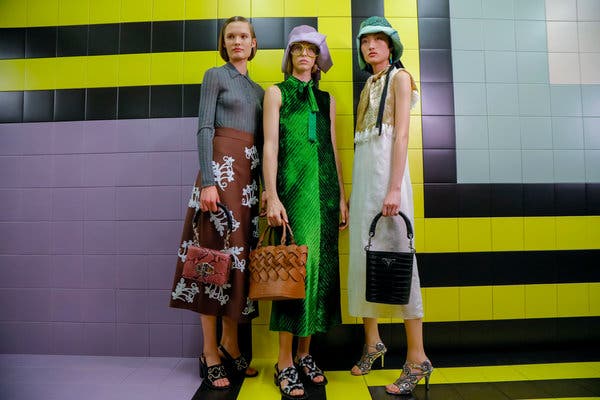
MILAN — Not that long before Milan Fashion Week and his presentation, Brunello Cucinelli, the Umbria-based fashion mogul famous for his ability to combine extreme casualness, high luxury and the musings of Pericles, was visited by Luigi Di Maio, the political leader of the anti-establishment Five Star Movement. Mr. Di Maio was wondering if Mr. Cucinelli might want to run for office.
“You’re always talking about big ideas,” Mr. Cucinelli said Mr. Di Maio had told him. “Why not put them into action?”
Mr. Cucinelli said he responded thank you but no thank you, and sent Mr. Di Maio home with a book combining the speeches of Barack Obama and Marcus Aurelius that Mr. Cucinelli had made for his employees.
Sometimes, he said, standing amid a collection of slouchy beige linen trousers and hand-knit cabled sweaters that dipped off one shoulder, and could take one person as long as 40 hours to make, you have to stick with first principles. Avoid “the fads and distractions of the moment,” as his show notes read.
There’s been a lot of talk about sustainability over the past two weeks of collections, and about fashion’s role in the climate crisis. The Swedish student-activist Greta Thunberg has made waves and not just because of her sea journey to the United States. Most of the time the conversation has been focused on manufacturing and carbon emissions; the corrosive effects of a small army of people flying to and from four cities in four weeks to pass judgment on a host of skirts.
But the idea of creating clothes that last — that people want to buy and actually keep, and keep wearing; never throw out or recycle or resell — is as important a part of that subject as organic cotton and ending the use of hexavalent chromium in tanning. And Mr. Cucinelli isn’t the only designer thinking in that direction. Suddenly, timelessness is being touted as a core value, even in Milan, the fashion-month city most closely associated with the notion of setting off retail trends.
Not by everyone to be sure. Not by Alberta Ferretti, whose attempts to shake up an association with the delicate chiffon party dresses once synonymous with her name led her down an unfortunate hippie-dippie Woodstock rabbit hole complete with washed-silk butterfly caftans, tie-dyed denim, psychedelic suede patchwork and shorts suits.
And not by Max Mara, whose dream of outfitting a female James Bond mired the brand in very-last-century men’s wear tropes, all military tone-on-tone three-piece suiting complete with epaulets, waistcoats, giant utility pockets and ties.
Ties? Men have been trying for years to liberate themselves from the accessory. Why a woman who was breaking one tired gender stereotype would suddenly embrace another is unclear. This brand can make a genuinely forever trench. If there was a moment for that kind of restraint (the kind that creates breathing room), it is now.
It was there at Luke and Lucie Meier’s Jil Sander, in a sleeveless gown pieced together in a complicated chessboard of ivory and cream; a collarless, lapel-less overcoat, a single button offset at the waist; the exclamation point of a silver bird in flight on the knee of a black bias-cut gown. In a long white shirtdress in crisp cotton worn back to front, the better to expose its architecture. In raffia knots and fringe to add a touch of the hand to the austerity; dresses over pants and under jackets; and in the use of a marbled print to add a dash of earth tones to the palette of neutrals.
And it was there most surprisingly at Prada, where Miuccia Prada stood, dwarfed by a scrum of celebrities and editors after her show, preaching the gospel of non-disposability, reduction, purity. “The person should be more important than the clothes,” she said. Today, “we need to do less. There is too much fashion, too much clothes, too much of everything.”
Too true.
Still, it was something of a statement coming from Mrs. Prada, a woman who made her name on her tendency to about-face from season to season, to put her nose to the wind, follow her sense of smell and explore what direction identity was going at the moment (muchness! minimalism! 1970s waitresses! Japanese manga!) even if it led her in a totally different direction than her most recent collection — even if the net result was that her customer had to practically buy a whole new wardrobe each time.
Asked if she felt in part culpable for the glut, she said, “Of course.” She’s trying — not to backpedal, but to recalibrate. With her pearls of wisdom came mother-of-pearl.
Literally: in big, iridescent shell necklaces tied and layered over single-breasted princess coats in black velvet, falling cleanly below the knee. Also simple little chemises of cream or black or shell-pink gauze, sometimes with flapper tiers, sometimes embroidered with a single, stylized silver-sequined feather or two. Also skirt suits, the jackets marked by oversize belt loops left empty to just suggest the idea of waist; rough-edge leather tops tied on at the shoulders and sides in lilac and emerald green; geometric Midcentury Modern knits; sleeveless devoré velvet columns in a chevron pattern, knotted at the neck.
The line was narrow, just skating over the body; the mood was elegant efficiency. These were clothes that did not demand too much. Almost everything was shown with a cloche rain hat. Because you never know when the sky will fall. Here’s what you can wear in the meantime. Pretty much any time.







